What is an e-commerce marketplace, and how to build one
You don’t need inventory, warehouses, or expensive technology to start an e-commerce business. By building an e-commerce marketplace, you can connect multiple sellers and buyers through one platform. Here’s how.
E-commerce marketplaces have proven to be an incredibly successful business model.
As the e-commerce sector continues to grow, marketplaces are taking a larger and larger share of the value. In 2027, global B2C e-commerce is estimated to reach $5.5 trillion at a steady 14.4% compound annual growth rate. And by the same year, marketplaces are expected to account for 58% of global e-commerce.
A key reason why e-commerce marketplaces are such phenomenal businesses is that they need a much smaller investment to launch and grow than traditional online stores. These platforms work by connecting multiple individual sellers (who run their own inventories) with buyers, and take a share of each transaction they facilitate.
This makes marketplaces an accessible business model for early-stage founders.
In this guide, we’ll take you through what you need to know if you’re curious about the e-commerce marketplace business model and consider starting your own.
You’ll learn how e-commerce marketplaces work and make money, and where the possibilities lie for new founders. You’ll also get a step-by-step process that takes you through validating your idea, building a platform, seeding your user base, and growing and scaling your business.
An e-commerce marketplace is an online platform where independent sellers list products, buyers purchase them, and the marketplace operator facilitates the exchange.
Amazon, Ebay, Alibaba, an Etsy are examples of large, horizontal, global e-commerce marketplaces, but the model also thrives on a niche focus.
And it can work with any audience group: B2C marketplaces, like Amazon, are the classic examples, but investors see a lot of opportunity in B2B marketplaces, and platforms like Vinted are increasing the interest in C2C e-commerce (often also called “recommerce”).
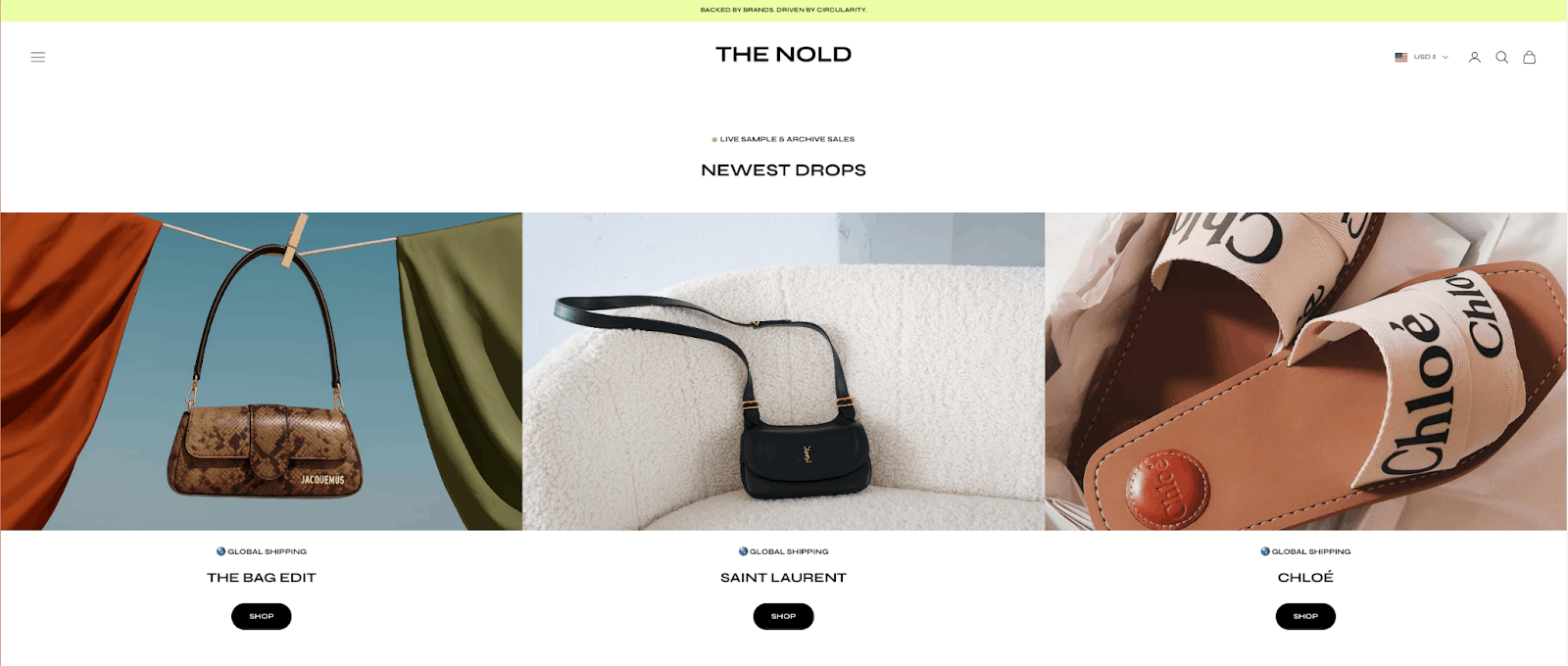
Unlike a traditional online store run by a single vendor, a marketplace brings together two user groups: sellers (or providers) and buyers (or customers). The operator’s role is to enable smooth transactions between these groups.
Traditional e-commerce businesses make money on the profit margins of the products they sell. E-commerce marketplaces make money on the value they provide by connecting buyers and sellers: through commissions, subscriptions, or listing fees.
(Note that there are also categories of e-commerce marketplaces that don’t deal with selling products, like Amazon. Rental platforms like Airbnb or service sites like Upwork are also examples of e-commerce marketplaces. If you’re interested in learning more about how these models work, check out our guides on how to build a rental marketplace and how to build a service marketplace. In this article, we’re continue to focus on discussing product-selling marketplaces like Amazon, eBay, and Etsy.)
The most common business model among successful e-commerce marketplaces is commission, where the platform takes a cut (typically between 5 and 25%) out of each transaction it facilitates. (You’ll learn more about choosing your business model and all the other important steps of launching and growing an e-commerce marketplace later in this article.)
The marketplace model works so well because it solves problems for both sides. Sellers gain access to customers they couldn't reach on their own. Buyers get selection, price competition, and convenience.
And you, the marketplace founder, get a scalable business that grows by adding sellers rather than buying inventory.
E-commerce marketplaces combine low startup costs with high scalability.
Consider starting a traditional e-commerce store. You might need to spend $50,000 in inventory upfront, store it somewhere, hope it sells, and risk unsold stock if you guessed wrong about demand. With growth, the capital requirements and risk compound.
In the marketplace model, your sellers create your inventory. You could launch an e-commerce business with 20 sellers who each hold a stock worth $2,500. You test demand in weeks by watching what sells. You scale by recruiting more sellers, not buying more stock.
Of course, building an e-commerce marketplace platform is also an investment that includes risk. In fact, marketplaces are some of the most complicated websites there are, and require much more functionality than a standard e-commerce store.
However (as you’ll learn later), today’s technology tools have significantly brought down the cost of building a marketplace platform. For example, Sharetribe’s marketplace builder lets you launch an e-commerce platform in a matter of days. This means you’re much better able to test and iterate before making a bigger investment.
Finally, marketplaces benefit from a dynamic not available for regular e-commerce businesses: network effects.
In network effects, every new user of a product increases its value to all users. For example, the more people have a telephone or use LinkedIn, the more valuable these products become. Marketplaces follow a similar pattern: every new seller makes a marketplace more interesting for buyers, and the increased buyer potential attracts more sellers.
This means that marketplace founders can witness a positive feedback loop where growth generates more growth.
All this makes the marketplace model very popular in the startup community.
The venture fund FJ Labs, which exclusively invests in online marketplaces, says they continuously evaluate between 40–50 new pitches from marketplace founders every single week.
This is proof that giants like Amazon and Alibaba have not yet saturated the market. In fact, there’s a growing opportunity for e-commerce marketplaces that focus on serving a single niche extremely well.
No two questions about it: Amazon and Alibaba dominate e-commerce. They have massive scale, infinite selection, and billions in capital. Competing with them head-on is a race you can’t win.
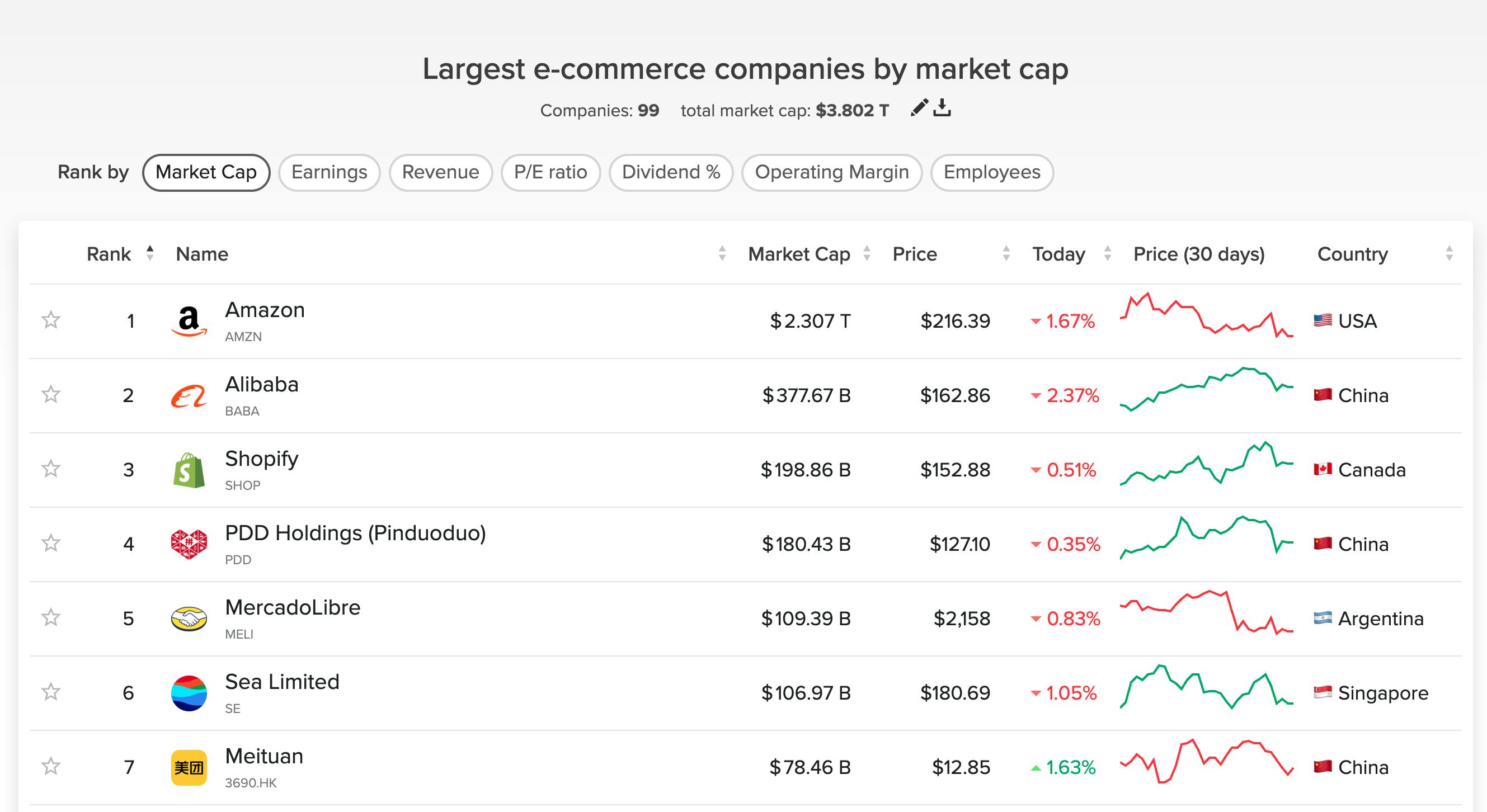
But here's what the Amazons of the world can't do well: serve specialized niches with deep expertise, curated supply, and passionate communities.
This is where your opportunity lies. The riches are in the niches.
Vertical marketplaces thrive by focusing on specific categories where generalists can't compete.
For example, Reverb, an online marketplace for new and used musical instruments, generated $30–40 million in annual revenue when Etsy acquired it for $275 million in 2019.
Grailed processes well over $100 million in annual GMV with its men's fashion resale marketplace by serving sneakerheads and streetwear enthusiasts.
GearSource, built on Sharetribe, serves audio professionals with a marketplace for pro audio equipment—a category that requires specialized knowledge Amazon can't match.
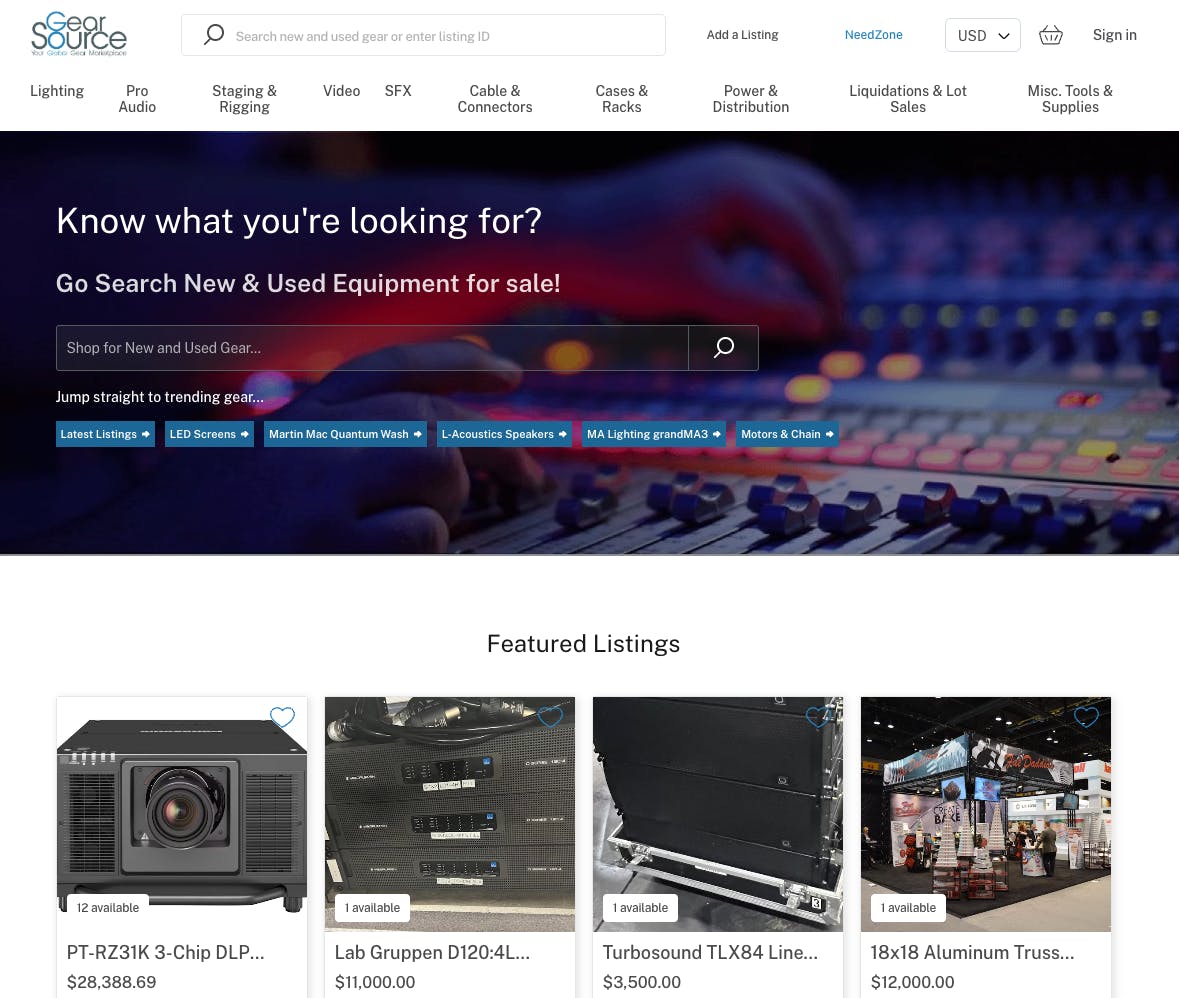
The pattern repeats across industries. When you focus on a specific niche, you can build features, curation, and community that matter to that audience. You understand their language, their problems, and what makes a transaction successful in your category. Amazon treats pro audio equipment the same as kitchen gadgets. You don't.
In fact, even most of today’s biggest, most successful horizontal platforms first got started with a niche focus.
Many of today’s most successful e-commerce marketplaces started with a narrow niche, simple technology, and a focus on building liquidity in one category before expanding.
Amazon launched in 1995 as an online bookstore with a basic, text-heavy website. In an early interview, Jeff Bezos said he picked books because they offered a unique advantage among items: the category had over 3 million titles globally. With so many items, it was possible to build an online store that couldn’t exist in any other way.
Initially, Bezos’ book-selling business was retail: he bought inventory and sold it through the Amazon website. Before introducing a marketplace element, the retail business expanded to more categories, including videos and DVDs, electronics, and home improvement.
In early 1999, Amazon launched Auctions to compete with eBay, and in late 2000, Amazon Marketplace was launched. The website was bare-bones—text listings, basic search, prioritizing inventory breadth over design polish.
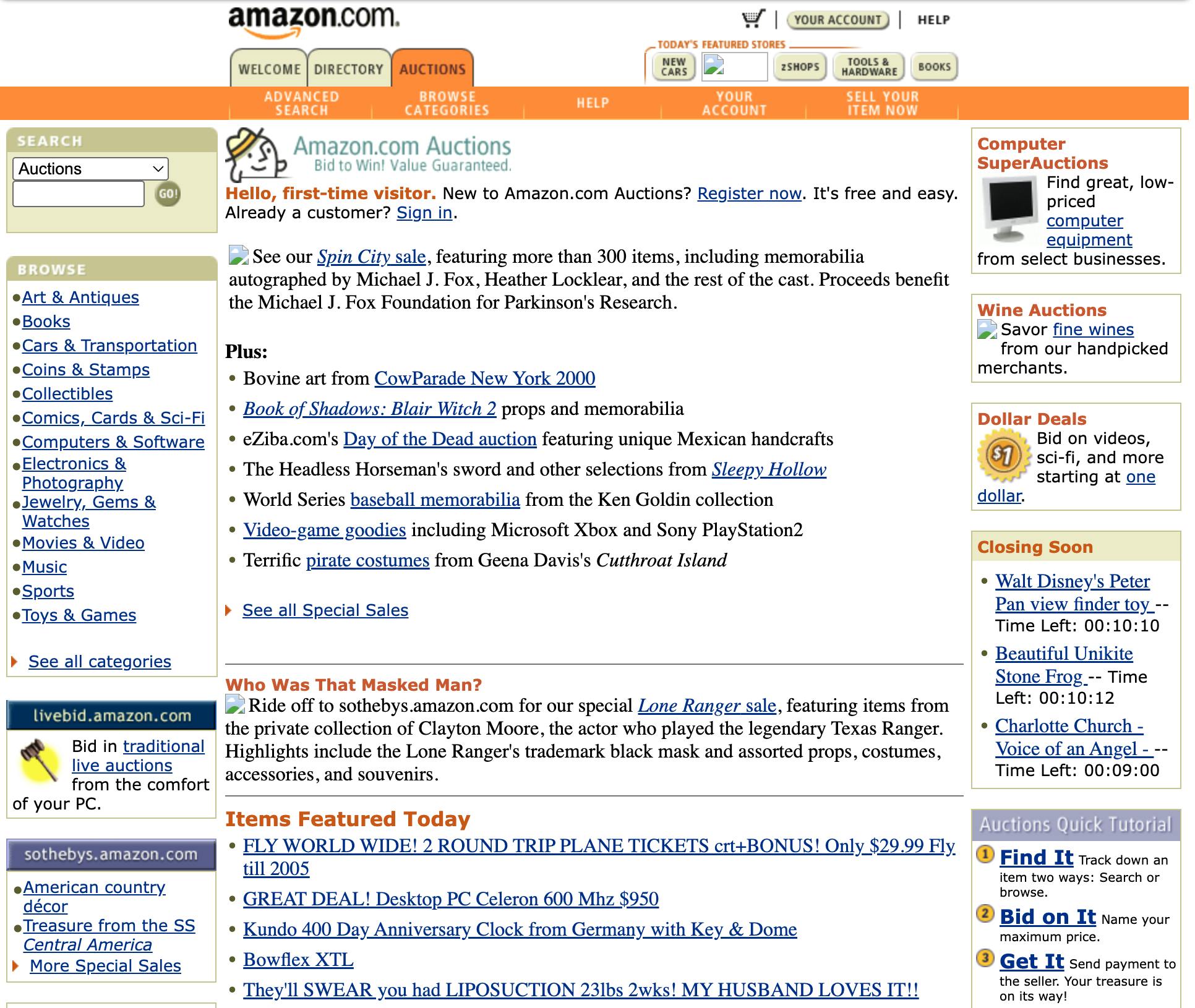
The key lesson lesson: solve one category extremely well before attempting everything. Even Amazon, which later became "the everything store," started by mastering one vertical.
eBay launched in 1995 as AuctonWeb, founded by Pierre Omidyar. Initially, the platform focused exclusively on person-to-person auctions for collectibles like Pez dispensers, coins, stamps, memorabilia. A key moment in the company’s history was the Beanie Baby craze in the late 90’s, during which $500 million worth of Benie Babies were sold on eBay.
Unlike most of today’s top e-commerce marketplaces that have fixed prices, eBay’s format was auction-only until the introduction of the “Buy Now” button in late 2000. The auction-only format matched how collectibles markets actually worked: sellers wanted to maximize prices through bidding, and buyers wanted to hunt for deals and rare items.
Another eBay innovation were mechanisms to build trust. Trust is crucial for any marketplace, and especially for the collectibles market where the authenticity and condition of products matters greatly.
As early as 1996—only six months after the company’s launch—Omidyar introduced the Feedback Forum to allow buyers and sellers to rate each other publicly.
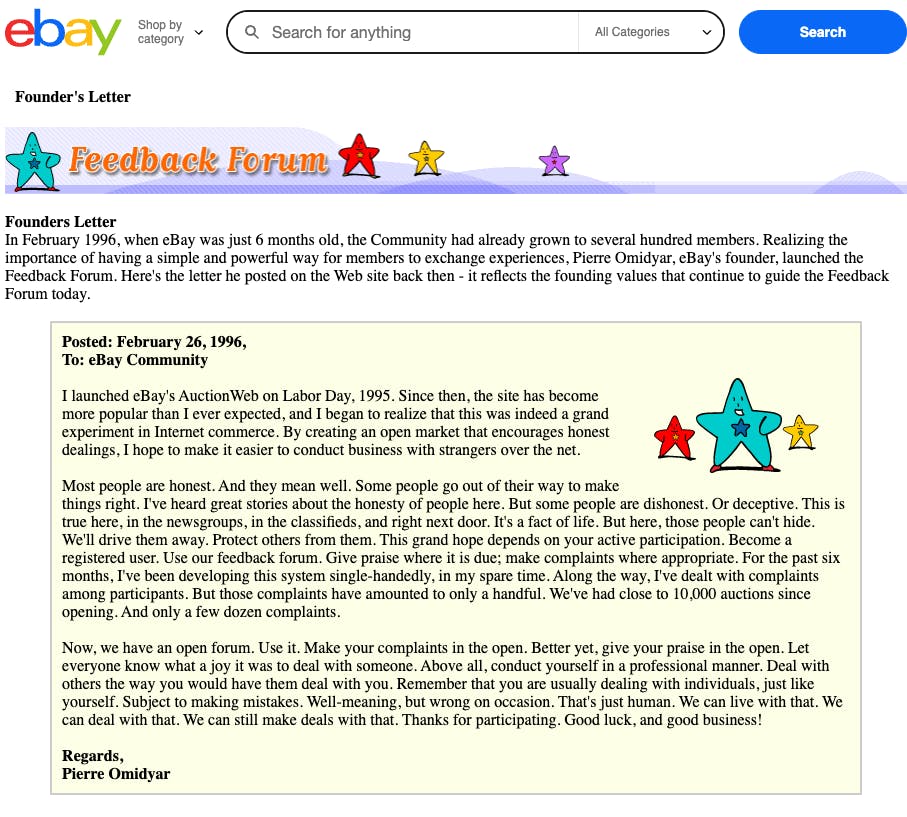
The feedback rating system became eBay's defining feature, solving the trust problem that kept person-to-person transactions offline. Since then, the platform has added further trust mechanisms like verification and buyer protection.
The lesson: Pick a niche where your marketplace’s unique value solves a real problem. eBay’s biggest innovation wasn’t the basic html listings, but the trust architecture that made peer-to-peer online transactions possible.
Even today, niches where the requirement for trust is high present a great opportunity for e-commerce marketplaces.
Etsy launched in 2005, founded by Robert Kalin, Chris Maguire, Haim Schoppik, and Jared Tarbellwith. In the beginning, it had strict rules: handmade goods, vintage items, and craft supplies only.
The category restrictions created differentiation from eBay’s “anything goes” approach and Amazon’s ambition to become “the everything store”.
There’s a great lesson right there on competing against the giants by focusing on a niche, but Etsy didn't just differentiate on category focus.
They built a community centered on values of supporting independent creators, keeping commerce human, and choosing handmade over mass-produced. It built forums and seller tools that continue a part of Etsy’s core offering today, emphasizing community, creativity, and ethical commerce. The mission-driven positioning attracted sellers who wanted more than just a transaction platform.
This focus worked. In 2015, Etsy went public, raising over $287 million and reaching a value of more than $3.5 billion.
However, as the company grew, its seller community got increasingly dismayed. Already in 2013, Etsy changed its policy to allow sellers to hire employees and use factories to produce their items—a move that was ironically labeled as redefining the meaning of “handmade”.
Since then, frequent analyses have come out on how Etsy’s policies alienate its crafters and cost Etsy its distinctive identity. This has created an opening for alternatives like Handmade.com that maintain strict handmade standards.
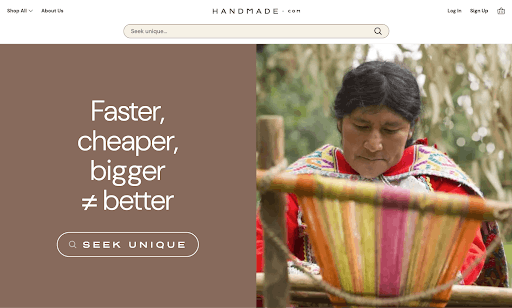
The lesson: A strong category focus combined with a values-based positioning can turn your marketplace from a platform into a community, which represents a powerful competitive advantage. But if you fail to maintain the standards that made you different when growth pressures mount, competition will rise to the occasion.
These examples teach the same lesson: launch with one niche, minimal features, and obsessive focus on proving buyers and sellers will transact—not perfecting technology.
Amazon, eBay, and Etsy all identified a category or a user segment where an e-commerce marketplace could offer unique value. The technology that powered their early versions was remarkably straightforward, even by the web standards of their respective launch periods.
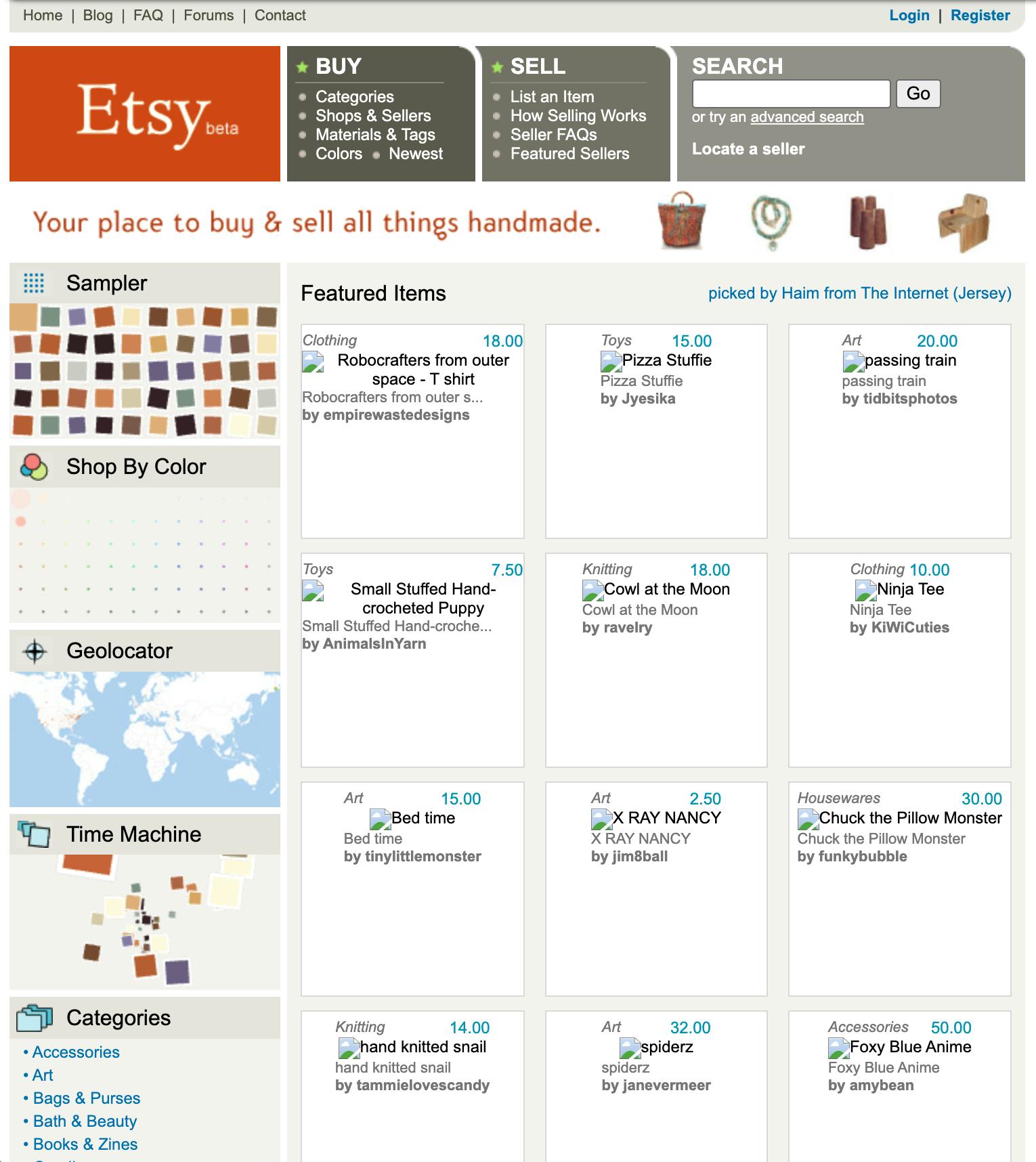
Instead, each prioritized functionality and trust—whatever the key requirements were for their respective markets standing in the way of users completing transactions.
In a similar way, you should fight the urge to add features before proving the core transaction works.
Of course, this isn’t to say your first version in 2025 can be just as simple as eBay’s was in 1995. The standards have changed, and today’s users expect a lot of capability in the UX, trust mechanisms, and online payments from the get-go.
Luckily, the tools have also evolved. Today, marketplace builders (like ours at Sharetribe) let you a launch a fully functional marketplace website, complete with user profiles, listings, online payments, reviews, and more, in a matter of days—and even entirely without coding.
This lets you replicate the core strategy behind the early success of today’s largest e-commerce marketplaces without a huge budget.
We’ve established that focusing on a niche and serving it well—even with relatively simple technology—is a winning strategy for an early-stage e-commerce marketplace.
But how to go about that in practice?
Next, we’ll discuss concrete steps for building an e-commerce marketplace:
- Find and validate a great e-commerce marketplace idea
- Choose a revenue model
- Build your e-commerce MVP (Minimum Viable Platform)
- Build your early supply and demand
- Reach problem-solution fit and product-market fit
- Scale into new markets
The core principle behind all the stages is to repeat the successful early formula of Amazon, eBay, and Etsy: find an idea where you can provide unique value, do whatever it takes to get your users transacting as quickly as possible, and grow and expand gradually so that you preserve the key marketplace dynamics.
Your marketplace idea must solve a real, painful problem for both sellers and buyers. The most common reason marketplaces fail is solving problems nobody has.
Strong marketplace ideas share three characteristics:
- They unlock idle assets (eBay tapped into the value in used and surplus goods in people's closets, Etsu saw the potential in individual creators and crafters to sell their goods).
- They aggregate fragmented supply (collecting many small sellers into one searchable place, like Etsy did with crafters or Reverb with musical instrument dealers).
- Or they add trust to existing but inefficient markets (like eBay did for peer-to-peer collectibles transactions).
You already learned that the easiest way to meet these characteristics is to focus on a niche, like Amazon, eBay, and Etsy did.
Once you’ve found such an idea, validate it. Before building anything, find 10 potential sellers and 10 potential buyers and talk to them to figure out if they truly experience the problem you assumed they have. The information you get will be invaluable for refining your concept, planning your business model and pricing, and communicating your value proposition.
Even better, by doing the work of talking to your target audience early, you build relationships and a sense of commitment that can help you later when you’re seeding your initial user base.
For exploring marketplace opportunities and spotting strong ideas, see our guide on how to come up with a great marketplace idea and why you should constrain your marketplace to one niche or location. For complete validation frameworks and recommended interview questions, see how to validate your marketplace idea.
A key decision before you start building a platform is how you’ll make money.
Our research on the revenue models of top 100 marketplaces shows that 80% of marketplaces selling physical goods use commission as their only revenue stream.
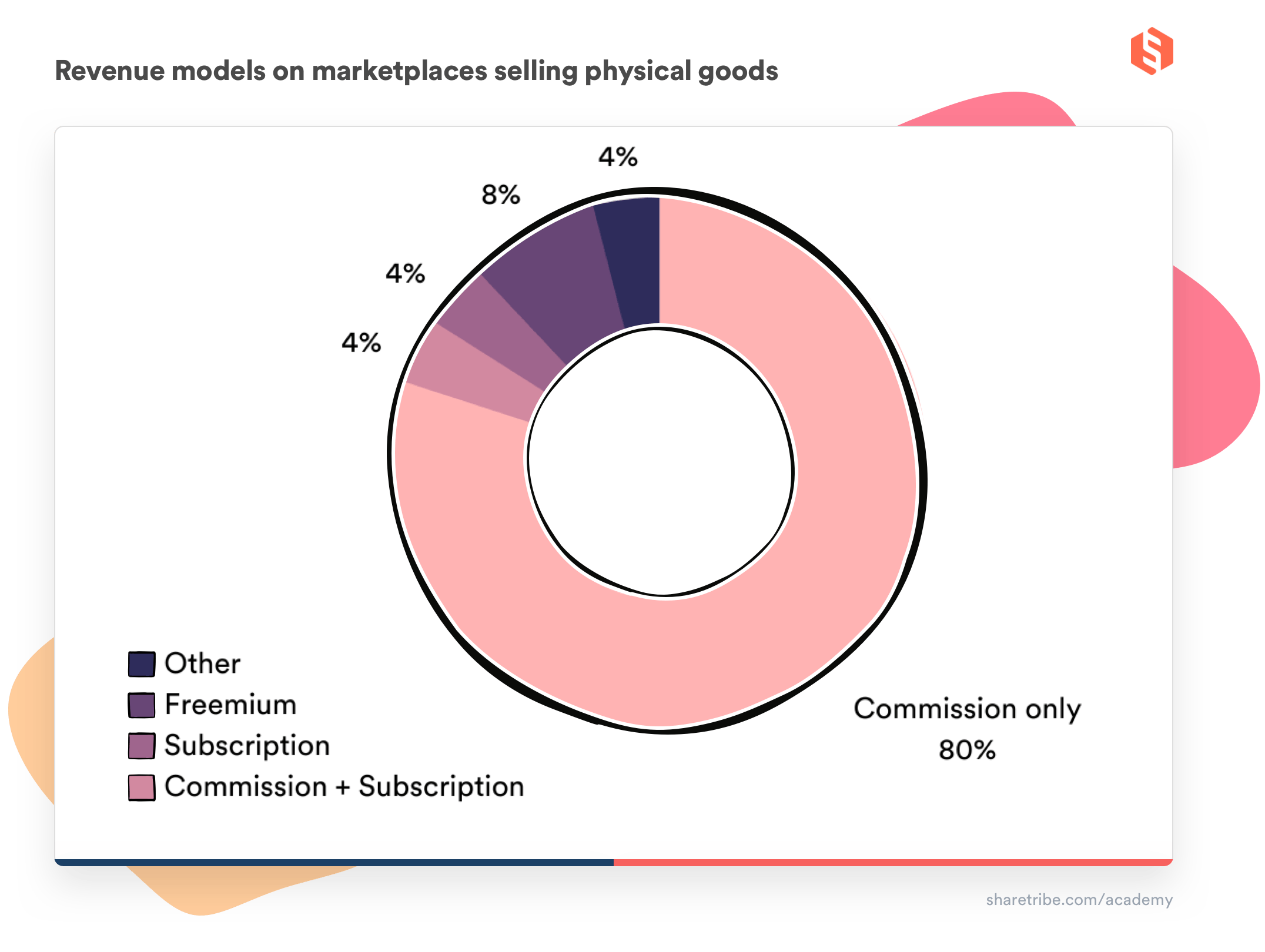
The main benefit of this model is that it aligns incentives and scales with volume. Your sellers will only need to pay you when they make a sale themselves, which removes friction from joining your platform. And as transactions on your platform increase, so does your revenue.
Some e-commerce platforms may use additional revenue streams on top of commission. Subscriptions, listing fees, and featured listings or ads are the most common.
In the subscription model, you charge users (sellers, buyers, or both) recurring payments for access to your platform or for premium features. In listing fees, sellers are charged a fee on each listing. Featured listings or ads mean allowing sellers or third parties to pay for visibility on your platform.
For example, Amazon, eBay, and Etsy all use commission as their primary revenue model but layer on additional streams.
Amazon charges 8-45% commission (called "referral fees") on most categories, with a $39.99 monthly subscription fee for professional sellers. They also monetize through advertising and premium placement options.
eBay's model is similar: it has an “insertion fee” for sellers that exceed 250 listings per month, and a commission called “final value fee” between 3–15%.
Etsy combines a small listing fee ($0.20 per product) with 6.5% commission plus payment processing fees, and a possible one-time setup fee. It also offers an “Etsy Plus” subscription for brands and offers promoted listings for sellers who want additional visibility.
For most e-commerce marketplace concepts, the main takeaway is to start with a commission structure to align your incentives with the early providers’. Then consider adding optional paid features or fees as your marketplace matures and you provide more value. Complex pricing is also a source of friction—and a simple, fair pricing structure can be a competitive advantage against competitors.
For detailed analysis of pricing benchmarks and when each model works best, see how to choose the right business model for your marketplace and how the top 100 marketplaces monetize. For help on finding the right pricing level, see our guide on marketplace pricing.
Once your idea is validated and refined and you’ve chosen a revenue strategy, it’s time to build the first version of your platform. The first step is to launch an “MVP”: a Minimum Viable Platorm.
The term MVP hints at the right scope for your first version: it should be minimal, but also viable—something that solves the main problem for both your sellers and your buyers better than any existing solution.
Build too little, and you won’t know if your business fails because of the idea or the execution. Build too much, and your timeline and budget will suffer because you wasted resources on things you didn’t need.
Well then, what does minimal and viable translate to, in terms of features?
The exact requirements for your e-commerce marketplace MVP will depend on your niche and competitive landscape. But for most concepts, the list likely includes:
- User profiles: Profiles help build trust between users by showcasing key information like names, photos, bios, transaction history, and reviews.
- Storefronts for sellers: A way for sellers to showcase their entire offering on a single page.
- Listings: Sellers display their products with detailed descriptions, pricing, and photos.
- Search: A way for buyers to browse your marketplace’s offering and find what they’re looking for based on relevant criteria.
- Online payments: Secure and seamless payment systems are critical for trust and convenience. Integrated online payment methods (like Stripe Connect) handle transactions, enable commissions, and protect both buyers and sellers through features like escrow or delayed payouts.
- Reviews: Reviews allow users to leave feedback after transactions, which helps build credibility for sellers and transparency for buyers.
- Admin tools: Admin tools give you complete control over your marketplace, from moderating listings and users to setting transaction fees and handling disputes..
All these features, and many more, come built-in with Sharetribe’s no-code marketplace builder.
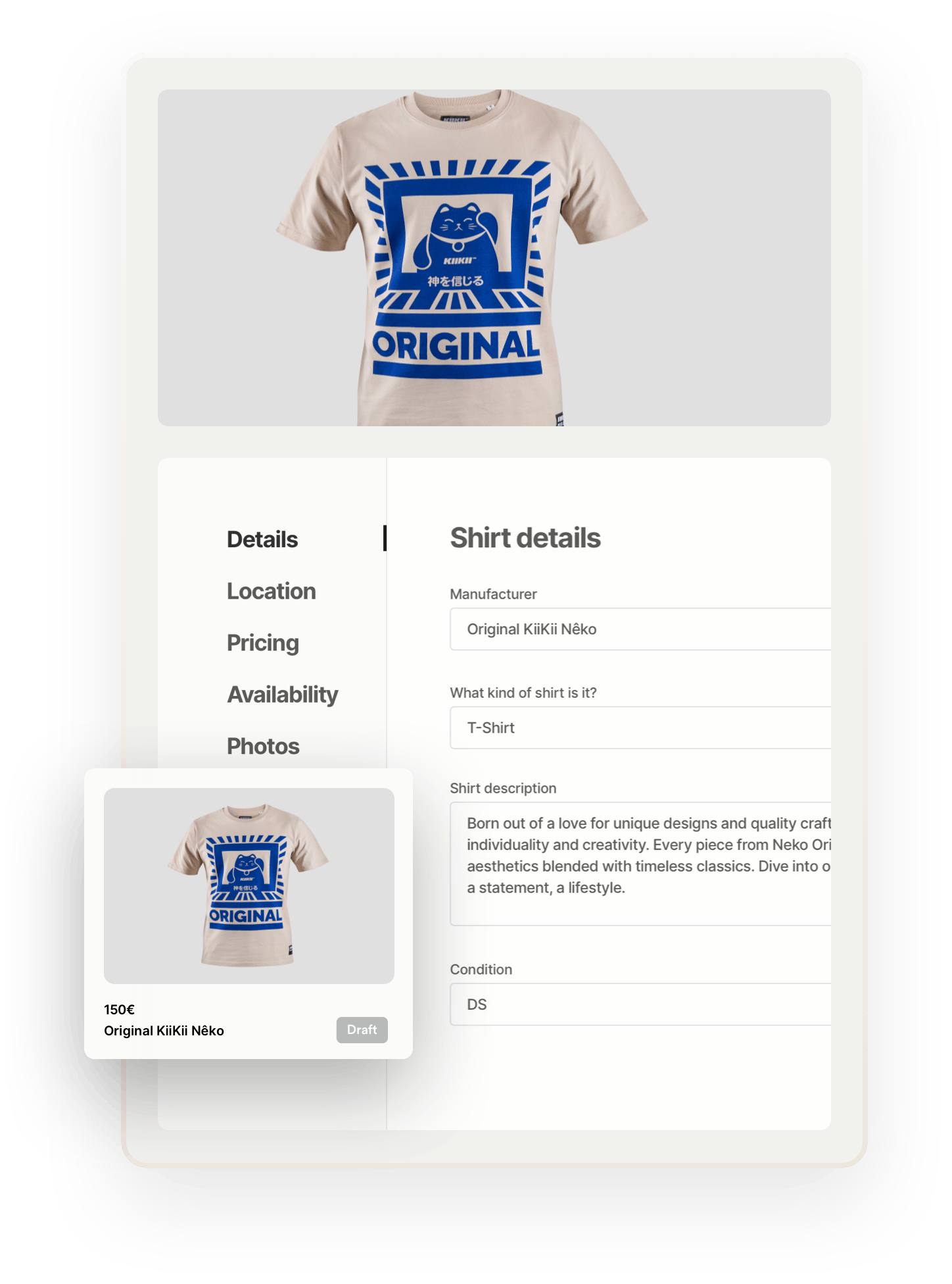
In addition to the essentials, some concepts might also require:
- Multi-vendor shopping cart: A way for buyers to add items from multiple sellers into a shopping cart and pay in one go. Here’s our guide on when you need this complex feature.
- Stock management: If your sellers hold large inventories of the same product, they might need tools to manage their inventory on your marketplace from day one.
However, consider carefully whether these are truly essential, or if they’re the types of improvements you can add later once your business idea is taking flight.
Once you have some understanding of the scope of your project, you have several options for building the actual website, including:
- Custom-code from scratch: Infinitely flexible, but costs a lot of time and money: very likely north of 6 months and $50,000, just for the basic functionality
- E-commerce builder and extensions: Tools like Magento and Shopify can be turned into multi-vendor e-commerce solutions with plugins. This is faster than custom-coding from scratch, but still requires time and skill and can be costly to maintain.
- Dedicated marketplace builders: The fastest way to launch is to find a SaaS solution that supports your key requirements out of the box, without coding. A benefit of a solution like ours at Sharetribe is that while you can get started without any coding, you can also add any features and capabilities to your platform as you grow.
Marketplaces are some of the most complicated websites there are. Custom-developing one from scratch can take upwards from 6 month and $50,000, just for the basic functionality.
But to re-iterate: no matter the technology you choose, only build what’s required to complete a successful transaction, first. Nothing more. Here’s a list of common features we see e-commerce marketplace founders build that you likely don’t need from day one:
- Advanced shipping integrations: in most cases, leaving the seller to set their shipping rates and handle logistics is enough at first.
- Wishlist or saved items
- Advanced seller analytics dashboards
- Mobile apps: initially, mobile web works fine in the early stages
- Advanced recommendation algorithms
- Multi-language and multi-currency support
- Seller-onboarding automation
- Automated refunds and disputes
- Tax handling for sellers
Many of these features would likely add value to your users, and you’ll probably want to implement some or all of them at some point. (When you hit that stage, we recommend looking into the e-commerce marketplace template created on top of Sharetribe by our expert, Journey Horizon. It offers a great starting point for enterprise e-commerce marketplaces.)
But in the early stages, a much better use of your budget, time, and focus is what truly makes your marketplace valuable: building and nurturing your user base. More on that next.
To learn more about the essentials for your marketplace technology, see our guides on building your marketplace MVP and on facilitating marketplace payments.
In the early days of your marketplace, your goal is proving buyers and sellers will transact, which validates that your marketplace solves a real problem.
To that end, you’ll need to build an initial supply of high-quality sellers and then bring in just enough customers for your early supply.
The supply-side first strategy works because sellers are usually more flexible. If they don’t have to pay to list on your marketplace, they’ll have the patience to wait a while before the demand shows up. Buyers, on the other hand, need selection from day one. If they come to your marketplace and don’t find what they need, they’ll leave and never come back.
Quality beats quantity at this stage. Ten active sellers with full catalogs of high-quality items beat 100 ghost sellers with one mediocre product each.
Once you’ve seeded your initial supply, you’re ready to launch your marketplace to the first buyers. Just enough so that there’s sufficient demand for your early supply—too little or too much means your user base is off balance, which will result in dissatisfied users on one side of your audience.
But where to go to find those early sellers and buyers?
If you conducted interviews with potential users in step 1, that list is a great starting point. Other great places to find potential users include:
- Generic online marketplaces and forums (think Facebook Marketplace, TikTok shop, small brands and creators on Instagram)
- Your direct marketplace competitors who aren’t serving your niche well
- Niche-specific sub-Reddits, forums, and communities
- Google, Yelp, business directories
- Local shop owners, crafts fares, pop-ups, farmer’s markets, and other local events
- University design programs
- Maker directories
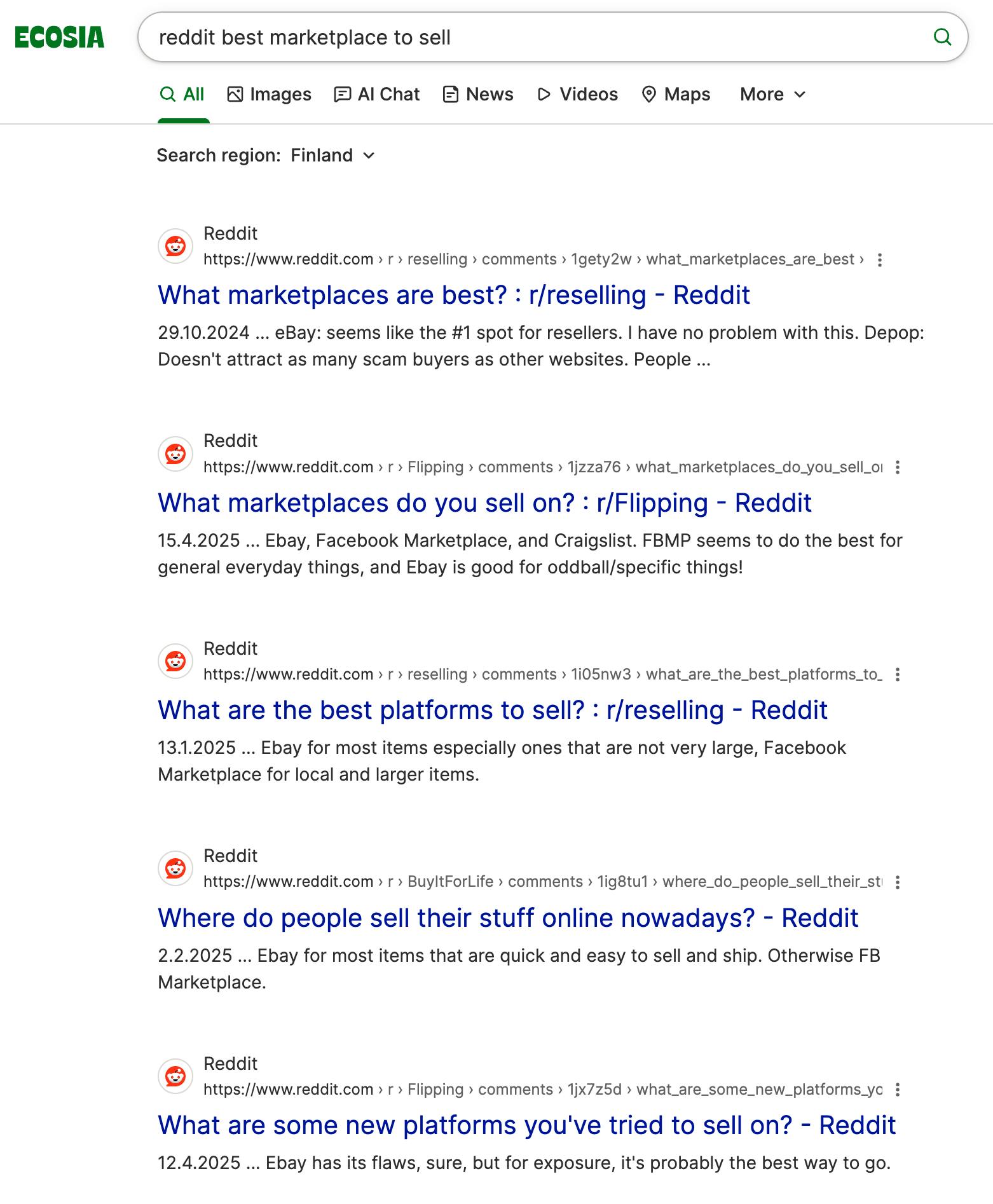
So, in the early stages, treat your first launch as a “product launch”, where you open your marketplace in beta to a select audience.
Also, be really close to this early group of people: see how they interact, where they drop off, and what painpoints they have. Help them make listings, find what they’re looking for, solve problems for them. Interview them about their experience.
In short: do whatever it takes to make these two groups to transact—even if it requires lots of manual work. Having 50–100 users who’ve had a great experience on your marketplace is an infinitely better starting point for building a successful marketplace than having a thousand users who are only half-engaged.
For detailed supply-building tactics and comprehensive launch strategies, see our guides on how to build supply for your marketplace, how to launch your marketplace, and why you should launch your marketplace early.
After launch, your goal is reaching two critical milestones that prove your marketplace works and can become profitable: problem-solution fit and product-market fit.
Problem-solution fit is the stage where your marketplace consistently facilitates transactions between the two sides of your platform and collects revenue from that activity.
You've validated that there are at least some people on both sides of your marketplace for whom you're solving a problem well enough that they want to return. Your operational costs may still exceed revenue, so you may not be profitable yet—but you've proven the core mechanics work.
If they don’t, don’t get discouraged. Paul Graham has famously argued that the main reason why startups die is that their founders get demoralized (and that if you manage not to die, you’ll eventually get rich).
So instead of giving up, use this opportunity to fine-tune your concept. Analyze what’s preventing your users from completing a transaction and iterate on your product, inventory, or messaging.
Once you’ve reached problem-solution fit, the next stage on your journey is product-market fit.
Product-market fit means being in a good market with a product that can satisfy that market.
At this stage, you’re showing your marketplace can become profitable in your initial constraint—whether that's a single category, location, or niche. Your unit economics work: the revenue you generate from users exceeds the cost of acquiring and serving them.
Until product-market fit, you’ll likely be doing things manually with a small initial group of users.
At the product-market fit stage, however, some further investment is likely needed to grow your user base and automate your marketplace to improve its cost-effectiveness.
If your e-commerce marketplace is powered by Sharetribe, adding new features with code on top of the no-code essentials you launched with will be easy. If you don’t have coding skills on your team, you can easily hire a developer from Sharetribe’s Expert Network.
The key metric connecting both these stages is liquidity—the likelihood that buyers find what they want and sellers make sales.
Simon Rothman from Greylock Partners said: "Liquidity isn't the most important thing. It's the only thing." This isn't hyperbole. Liquidity is your actual product. Without it, your marketplace doesn't work.
Liquidity is also the reason why starting with a narrow focus and small user base helps. It’s much easier to reach liquidity with a small group of users and then grow and expand what works.
If you instead start scaling your marketplace too soon—before you’ve reached liquidity, problem-solution fit and product-market fit—you’ll also scale the problems in your business model and make them harder to fix.
Scaling too early is a common cause of marketplace failure. As you’ve learned, many major e-commerce marketplaces started in one niche before expanding systematically. That’s not by accident: the marketplace model only works when there’s liquidity, and liquidity is much easier to achieve one niche at a time.
But once you've achieved product-market fit in your initial niche, it’s time to break out the rocket emojis. Your marketplace is ready to grow into new markets.
For a marketplace, there are three main ways to scale:
- By adding new locations
- By adding new categories
- By adding new customer segments
For example, both Amazon and eBay scaled by first adding new categories on top of the initial niche of books, and then started scaling to new countries. Etsy was global from day one, but most of its growth came from the US in the early days.
Choosing how you expand and what your next market should be boils down to five factors:
- Market size
- Cultural differences between your initial market and potential new market
- Competition
- Technology penetration
- Regulation
Once you’ve identified where your biggest scaling opportunity is, create your playbook. Document what worked in your first market: marketing tactics, supplier vetting process, timeline from launch to liquidity, and budget required. Note what didn't work and why.
Use this playbook to replicate success, but adapt it for each market's unique factors. If you need funding, a well-prepared playbook is great to show your potential investors.
For the complete framework on scaling strategies, market selection criteria, creating effective playbooks, and funding options, see our guide on how to scale your marketplace. Also check out our guide on if, when, and how to raise marketplace funding.
E-commerce marketplaces combine low startup costs with high scalability, making them one of the strongest business models for founders in 2025 who want to launch fast and validate product-market fit without inventory risk.
The opportunity for e-commerce marketplace is in niches, where even in crowded categories, specialized marketplaces can win by serving specific communities better than generalists like Amazon.
The key is to start small and simple: find a small group of initial users in a your initial niche, and launch a simple but functional first version of your site as quickly as possible to validate your idea.
As your business takes off and starts to grow, you can start using your profits to add features to create better experiences for buyers and sellers. The time you’ve spent learning about your audience pays off multi-fold when you can focus your resources on building features you know users will love.
With Sharetribe, you can have a marketplace up and running in just days. Launch it as fast as possible, and start learning about your idea and audience. Once you know what works, Sharetribe’s developer platform lets you expand your platform infinitely with custom-coded elements.
For more help, check out our comprehensive guide on creating a marketplace for more tactics, tips, and ideas, based on over a decade of helping launch more than 1,000 new marketplaces with Sharetribe. You can also browse our customer gallery and founder stories for more inspiration.
Every journey starts with the first step. Take yours today—the world needs more marketplaces!
Start your free trial of Sharetribe today.
An e-commerce marketplace hosts multiple independent sellers on one platform, while a regular online store sells products from a single vendor. The marketplace operator facilitates transactions and takes a commission but doesn't own inventory. Sellers manage their own stock and shipping. The value you provide as a marketplace operator is aggregating supply, facilitating trust through reviews and policies, and bringing customers sellers couldn't reach on their own.
No. Marketplace operators don't hold inventory. Sellers manage their own stock and ship directly to buyers. Your role is connecting supply and demand, facilitating transactions through your platform, building trust between strangers, and taking a commission when sales happen. This dramatically reduces your startup costs and risk compared to traditional e-commerce.
Handpick your first sellers from your validation phase or from online or offline communities related to your niche. Offer launch incentives like free listings or reduced commissions for the first six months. Promise to drive buyer traffic through content marketing, partnerships, and paid ads. Make it exclusive by positioning your marketplace as curated and accepting only quality sellers. Focus on quality over quantity—10 active sellers with full catalogs create more value than 100 ghost sellers with minimal inventory.
Most marketplaces charge a commission (10–25%) on each sale. When a buyer purchases a $100 product with 15% commission, the seller receives $85 and your marketplace receives $15 automatically through payment splitting. Some marketplaces also charge listing fees (per product posted), subscription fees (monthly access), or advertising fees (promoted listings). Commission models align incentives—you make money when sellers make money.
Yes. Marketplace builders like Sharetribe include all essential features without requiring coding: user accounts, product listings, search, integrated payments with automatic commission splits, reviews, admin functionality, and more. You can launch the first version of your marketplace in a matter of days. Sharetribe also lets you expand your marketplace infinitely: you can customize further with integrations through Zapier, or hire a developer to custom-develop unique features later. But you start with a working marketplace immediately.
With marketplace software like Sharetribe, you can launch an MVP in a matter of days or a few weeks. Projects to customize your marketplace with custom code with one of our Experts average at around two months, but this highly depends on the level of customization needed. Custom development likely takes 6–12 months and costs north of $50,000.
Speed matters more than perfection at the MVP stage. Launch fast with a working marketplace, validate with real users, and iterate based on actual transaction data rather than assumptions.
What's the biggest mistake e-commerce marketplace founders make?
Building features instead of building liquidity. Founders waste months perfecting their platform, adding requested features, and improving design when they should be recruiting sellers, driving buyer traffic, and facilitating transactions. Liquidity—the likelihood that buyers find what they want and sellers make sales—is the only metric that matters before product-market fit. Everything else is distraction.
How much does it cost to start an e-commerce marketplace?
Starting with Sharetribe costs $39/mo to build (after the free 14-day trial), then $99–$399/month depending on transaction volume, plus 2.9% + $0.30 per transaction for payment processing through Stripe (with 50–500 free transactions per month included per plan).
A rough estimate for your total first-year costs if you're bootstrapping: $1,500–$5,000, including software, basic marketing, and minimal code customization.
Custom development very likely costs at least $50,000 and takes 6–12 months. The marketplace builder approach lets you validate your idea with minimal investment before committing significant resources.
Start your 14-day free trial
Create a marketplace today!
- Launch quickly, without coding
- Extend infinitely
- Scale to any size
No credit card required
